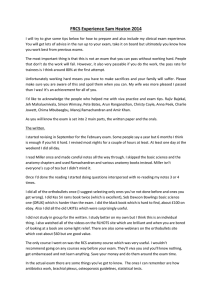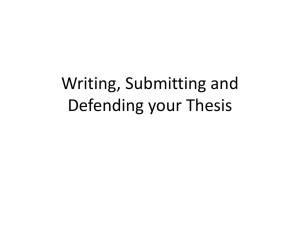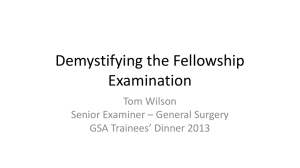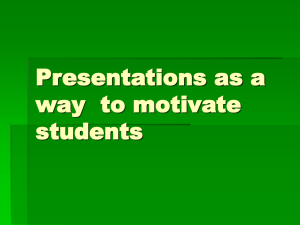Preparing for presentations and vivas
advertisement
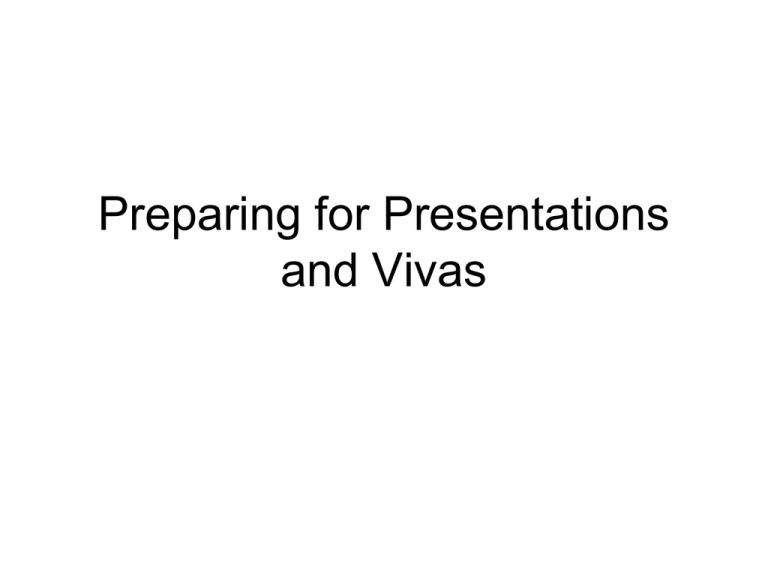
Preparing for Presentations and Vivas Objectives After this session you will be able to: • Plan and structure a presentation. • Deliver a presentation to meet the needs of your audience. • Use visual aids effectively. • Deliver a ‘professional’ presentation. • Prepare for and pass a viva. Preparing the presentation • Know your audience. • Know your academic programme (especially its requirements). • Reconnoitre facilities. Structure: beginning • • • • Greet audience. Introduce self. State title of presentation. When they can ask questions. Structure: middle The inductive approach: • Fact + Fact + Fact + Fact therefore Conclusion. The deductive approach: • Conclusion because Fact + Fact + Fact + Fact. The discursive approach • Argument For. Argument Against. Summary. Structure: end • ‘Flag’ the end: ‘So, in conclusion’ or ‘Finally…’. • Emphasize small number of key points. • Keep up energy and enthusiasm. Present complex processes by… Process A Process B Process D Process C Using [Custom Animation] in PowerPoint Create interest by… • Using personal stories. • Using cases. • Using metaphors (e.g., research revealed that management orchestrated the changes with great skill). Metaphors also allow for the use of visual images. Using visual aids – some deadly sins (design) The sin The consequence Using fonts that are too small. Inability of audience to read the information. Using endless bullet point slides. Complete audience boredom. Making slides ‘busy’ and packed with text. Inability of audience to process the information. Using too many colours or inappropriate colours. Audience confusion. Using too many animation effects. Audience distraction or irritation. Using visual aids – some deadly sins (delivery) The sin The consequence Facing the screen when talking, not the audience. Lack of ‘connection’ with the audience; less interest in the presentation. Reading from notes. See above. Technical problems such as the equipment not working. Embarrassed speaker and embarrassed audience. Flat, monotone delivery. Audience falls asleep or ‘switches off’. Delivery tips • • • • Gain attention. Use your body language. Project your voice. Handle questions politely. Making presentations interesting • Use visual aids – effectively. • Maintain eye contact. • Focus on the audience. • Be yourself. • By being relaxed, voice intonation/pace/ projection will be enhanced. From negative to positive thoughts Negative thoughts Positive thoughts I will ‘dry up’. I have practiced this. I am fluent. I don’t know enough. I am the expert in the room. Everyone will be looking at me. I will command their attention. I won’t know the answers to their questions. I know most of the answers; I can always open issues up for discussion. Avoiding stress…. • Practice, practice, practice (know the content and where to use visual aids). • Breathing…deeply and slow it down. • Remember the audience IS on your side. • Be aware of audience and talk directly to them. Team presentations Get to know each other Appoint a team leader Decide on and allocate roles Prepare a timetable Share out the content Plan the presentation Rehearse, rehearse, rehearse Preparing for a viva Vivas perform at least two important functions: • They test the candidate’s knowledge of their thesis to ensure that it is their own work. • They provide the candidate with the opportunity to defend their ideas and, if necessary, add further detail and explanation. Step 1: Select the examiner Choose examiners who are… Avoid examiners who are … Highly respected in their field. Unknown in their field. Working in a research area related to your own. Working in a research area unrelated or only tangentially related to your own. Broadly sympathetic to your central arguments. Likely to be antipathetic or even hostile to your central arguments. Publishing research using broadly similar methodologies to your own. Publishing research using methodologies that contrast sharply with your own. Step 2: Become master of your own work Common limitations include: • Key omissions in the literature chapters including omitting significant theories or sources. • A failure to present a set of coherent and well formulated research questions. • The lack of a coherent research design that is appropriate to the questions being asked. • Problems in sample selection, including a reliance on convenience or volunteer samples, and a failure to acknowledge the limitations of these. • Failure to acknowledge alternative interpretations of the data. • Making exaggerated claims on the basis of limited data. Step 3: Publish and reference your own article(s) • Good practice for academic writing. • Shows that you are capable of writing at the appropriate level. During the viva: typical questions What were your reasons for choosing this research topic? How did you set about dealing with ethical issues? What do you think is your original contribution to knowledge? What do you think are the main weaknesses of your work? What alternative research methodologies did you consider? What are the major recent developments in your subject area? How do your findings relate to the literature in your subject area? What would you do differently if you were to conduct this study again? What surprises emerged during your research? How does your methodology fit with your research questions? Have your opinions changed during the course of this research? What do you see as the next steps in this research? ‘Killer features’ the examiner looks for… • Has the candidate picked up the key debates in the subject area? Are there any vital sources or debates that have been missed? • Has the candidate identified the main gaps in the current literature on the research subject? Have these been clearly articulated? • From these gaps, have a set of research questions been posed? Are they clearly formulated? • Does the thesis contain helpful signposting to the reader? Is it easy to find one’s way about the thesis? Is it always clear what the candidate is trying to achieve in each chapter and section? • In presenting findings and discussion, does the candidate return to the original questions to answer them? After the presentation… • Be constructive about your performance and that of other students. • Reflect on what worked well and why. • Reflect on what could have been improved and why. • Celebrate the achievement of delivering to a large group. Summary – presentations • If preparing a presentation that will be assessed, keep checking on the assessment criteria and follow them. • Structure your presentation so that it has a clear beginning, middle and end, and keep to a limited number of key messages. • Avoid ‘death by bullet point’. Try to maximize the use of pictures, graphics and other visual images including the use of visual metaphors. • In delivering the presentation consider yourself as your best visual aid. Stand confidently and face your audience, making eye contact. Speak clearly with variety in your tone and intonation. • For team presentations, elect a leader and allocate roles based upon experience and commitment. Summary – vivas • In passing a viva, it helps if the external examiner understands and is not hostile to the research tradition which informs your research methodology. • If possible, get at least one of your own articles published in the peer reviewed literature. • Practice by undertaking a mock viva with your supervisor. • Know your work thoroughly including its main weaknesses. • Prepare to engage in a critical dialogue with the examiner. Remember, you know your research better than anyone in the room!





